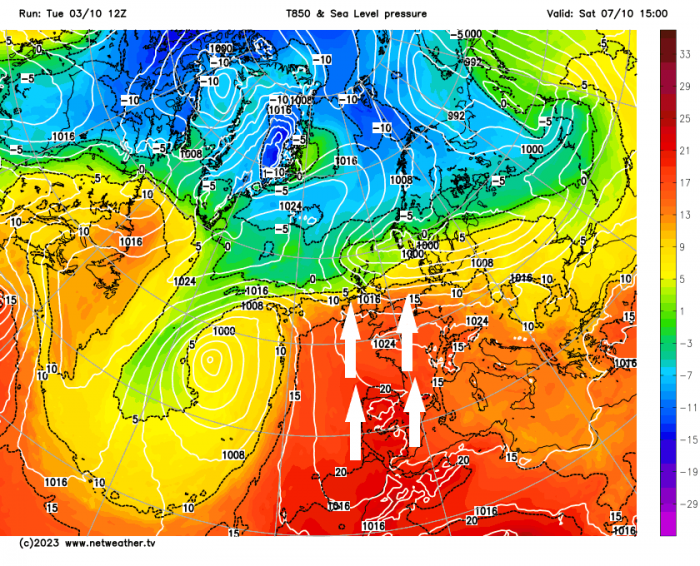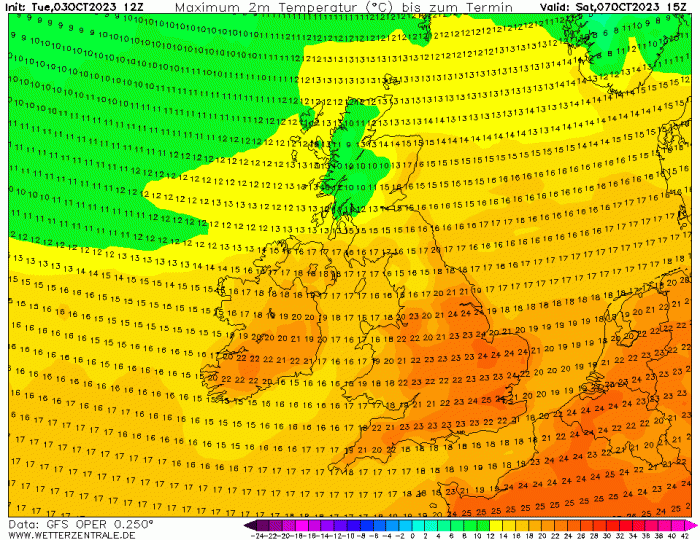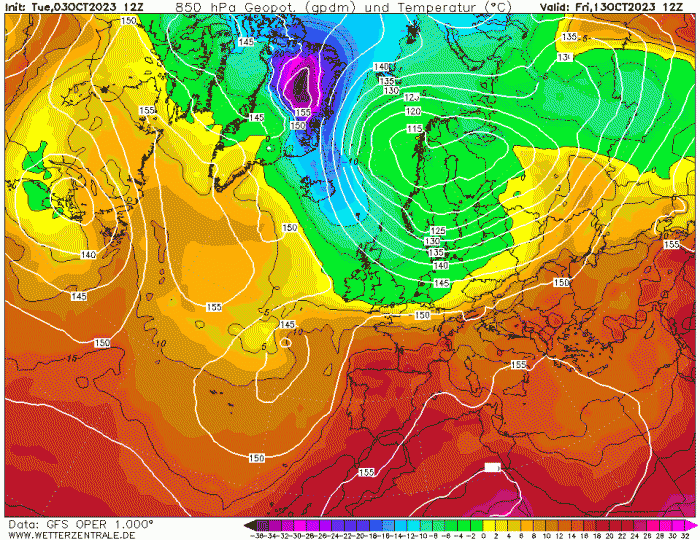
October continues the warmer than average trend that September finished with. This coming weekend could see temperatures reach 24-26C across SE England and East Anglia and generally reaching the low 20s Celsius across large parts of England and east Wales too.
The warm spell on the way this weekend for southern Britain, comes courtesy of hot air pushed north by a strong ridge of high pressure over Iberia and France later this week which builds further north across Britain. Some unusually high temperatures for early October across Iberia later this week and Saturday, GFS showing temperatures reaching the mid-30s Celsius across southern Portugal and SW Spain, as high as 37C in the Seville area. The average max for October in Seville is 27C. SW France reaching the low 30s Celsius too.

Some of this exceptional warmth looks to spread into southern Britain over the weekend too. GFS showing temperatures on both Saturday and Sunday widely into the low 20s Celsius across much of England and east Wales, but as high as 24-25C across SE England and East Anglia. GFS often underestimates max temperatures too, so 26-27C can’t be ruled out. Though the sun has much less strength than a month ago when we saw several days of 30C or more in early September.

The warmth continuing into next week too, with low 20s Celsius towards the southeast. But later next week, both 12z GFS and ECMWF show something much cooler with the flow turning northerly on Thursday. But it’s over a week away, so may change.

This warmth will naturally lead to media and people referring to it as an ‘Indian Summer’ – but is it?
The expression ‘Indian Summer’ owes its origin to North America rather than the Indian subcontinent. The first reference to it dates from the 1700s, around the time Europeans were rapidly settling the New World. It relates to the observations of Native Americans Indians along the American east coast - who are said to have taken advantage of mild autumnal weather to hunt and forage later in the day to build up winter food stocks. According an American Weather Historian, David Ludlum, it is said that in some areas that a true Indian Summer cannot occur after the first frosts of the autumn, a period known a ‘Squaw Winter’
However, there is no clarity for its use in the UK for warm weather in autumn.
The Met Office definition in a blog of theirs in 2013 is “An Indian summer is defined as a warm, calm spell of weather occurring after the first frost in autumn, especially in October and November”
While a Meteorological Glossary definition from 1963 doesn’t mention frost in it:

In the UK, some of the media seem to use ‘Indian Summer’ rather too liberally for any warm spell in September, October or November. But an unusually warm spell in October or November seems more sensible to class as an Indian Summer. The frost before the warm spell, and we are not talking just in the sheltered Glens of Scotland, is more of a grey area definition-wise.
Indian Summer or not, October is one of those pivotal months can encompass all seasons of the year. Sometimes it can feel like an extension of summer – with mellow golden sunshine and gentle warm breezes, the only reminder that it’s not summer being the misty or foggy mornings and getting dark earlier in the evening. But a reminder that it is the middle month of meteorological autumn can often be strong winds and lashing rain or even an unwelcome early taste of the colder months to come – especially later in the month, with frosts or even snow over northern hills driven by cold northerly winds.
Here's a look at extremes of warmth and cold in Octobers of the past – here are a few notable ones:
1974 – was a cold and rather windy month, with persistently northerly wind bringing showers of sleet and snow in northern districts throughout the month, especially over higher ground. On the 7th and again the last week, sleet or snow even fell in a few places across East Anglia and SE England, but did not lie for any length of time. Towards the end of the month, a few centimetres of snow accumulated on the slopes of the Grampians in Scotland. Temperatures were consistently below average throughout the month, with air frosts at times for inland areas. The monthly mean temperature ranged from 2C below average across northern Scotland to 3C below average in the south of England.
1985 – in contrast to 1974, October that year had a notable warm spell at the beginning of the month. The 1st was a hot day across central, southern and eastern areas of England – with temperatures 10C above normal. Waddon in Greater London recorded 29.5C, over half a degree higher than the previous highest October temperature in the UK. The following few days were warm but it gradually turned cooler for the rest of the month. In contrast, on the night of the 30th, Jersey Airport recorded a low of 1.9C, while St Helier on Jersey recorded a high of just 5.8C on the 31st.
1992 – the coldest October since 1974, northerly winds dominated. Everywhere was colder than average. Widespread showers on the 15th fell as hail but also sleet and snow over Welsh Hills. Snow was reported over the Cheviots and Pennines on the 16th and 23rd, snow also fell over southern Scotland and northern England on the 25th, with the A66 over the northern Pennines blocked by snow.
2001 – the warmest ever recorded, October was warmer than September. There were long sunny periods between the 9th and 13th, and it became very warm. The temperature reached 25.3 °C at Herne Bay (Kent) and in London on the 13th, this is exceptionally warm for so late in the year. Otherwise, it was often cloudy and an unsettled month, however, night minima were particularly high during the month. Many places reached 20C inland on the 30th, which is very warm for late October.
Cooler than average Octobers are becoming rarer, the last properly below average one was 2012. Global warming is making summers hotter and also the oceans warmer, so early autumn often tends to be more like summer, too.
More discussion on the term "Indian Summer" in the Netweather community forum
Loading recent activity...